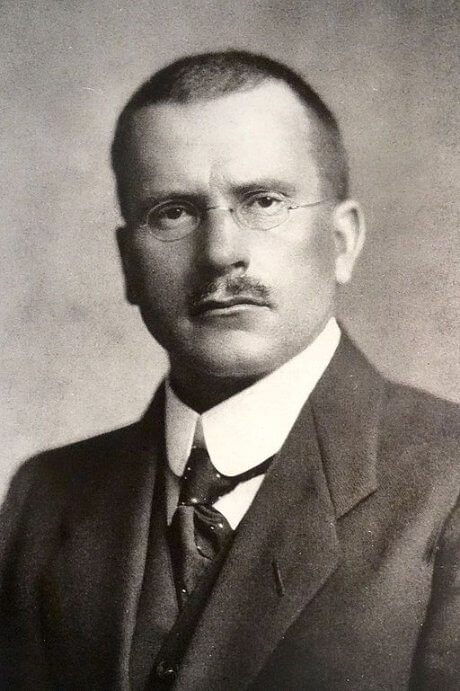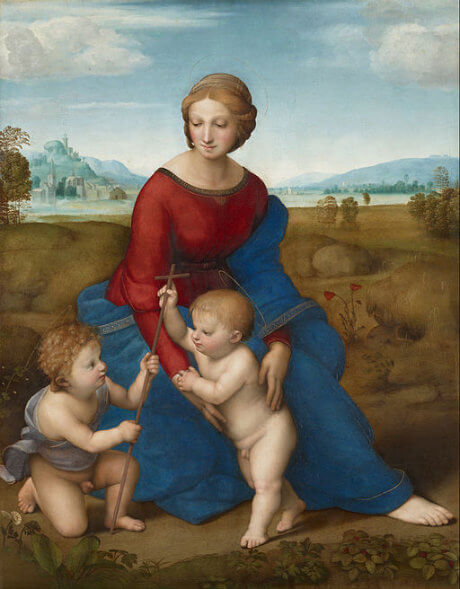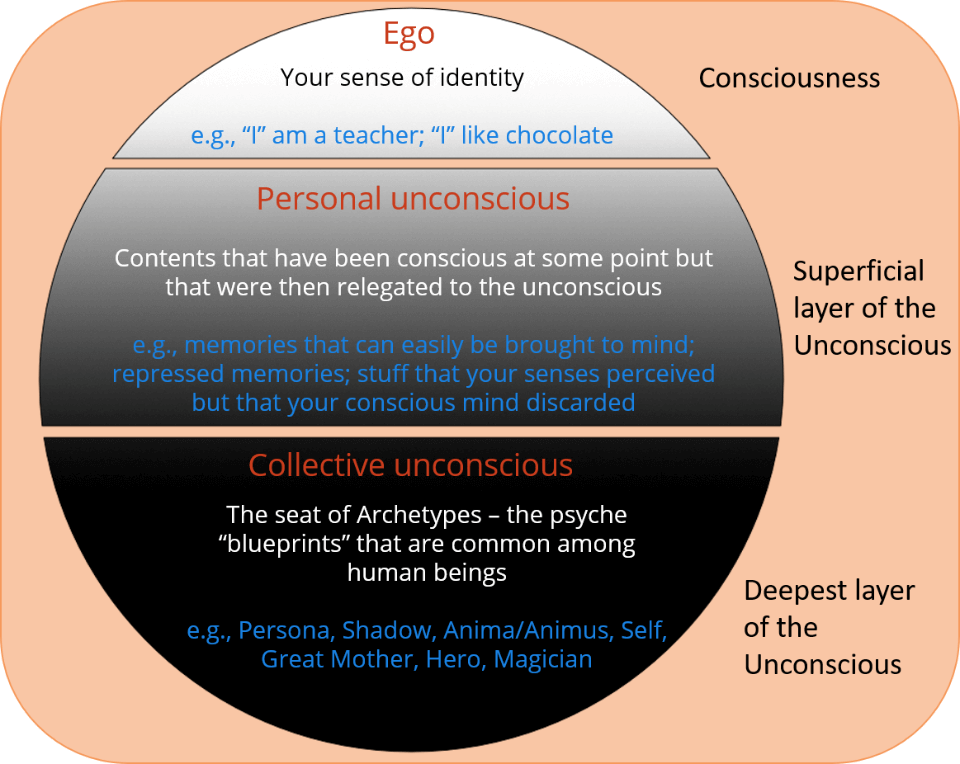This post is part of a larger deep dive
Curious about the role of Jung's dream theory and Jung's model of the psyche in Mulholland Drive? Check out Mulholland Drive Explained!
Or read the full Mulholland Drive article!
This post is part of a larger deep dive
Curious about the role of Jung's dream theory and Jung's model of the psyche in Mulholland Drive? Check out Mulholland Drive Explained!
Or read the full Mulholland Drive article!
In very broad terms, dream theories can be divided into psychoanalytical and physiological. In this article, I’ll focus the on a psychoanalytical theory of dreams developed by Swiss Psychoanalyst Carl Jung.

Before I do that, however, you cannot speak of dream interpretation without mentioning Freud, right?
I’ll cover Freud’s dream interpretation theory in detail in another article, but here is the general idea: Freud believed that dreams were the vehicle through which your childhood unconscious (mostly sexual) desires reached consciousness.
However, because of their disturbing content, they were being suppressed by an internal censor (a.k.a. Superego) and, along the process, transformed into something less disconcerting to the mind. In this way, you could go on sleeping without these disturbing wishes waking you up.
Well, Jung, a former disciple of Freud, disagreed with this idea. In simple terms, he believed that dreams were communicating important things that the unconscious wanted you to know, but that the conscious mind was too dumb to understand.
Before you understand why, let’s briefly discuss some of Jung’s main theoretical ideas.

Jung believed that over very long periods of time, the mind evolved particular “templates” that helped humans behave appropriately in a given situation.
He called these templates “archetypes”, and believed that they were common to every human being (I have them, you have them, your neighbor has them, and so on).
Here’s an example how one of these archetypes might have originated. Over time, our ancestors started to realize that mothers provided safety, food, and love. Over the course of several generations, this awareness resulted in the formation of the Mother archetype, which eventually got “imprinted” in the human mind. Once this imprint (the archetype) was created, every human being born thereafter inherited it.
This is very adaptive – a kind of a psychic natural selection if you like. Archetypes, according to Jung, could be even vital to survival in some cases. For example, shortly after you were born, you faced the situation in which interacting with your mother was required (e.g., because you wanted to feed). This situation activated the Mother archetype, helping you find your mother’s nipple (or cry if unsuccessful).
You are probably thinking that this sounds pretty much like instincts. Well, that’s because instincts and archetypes are two sides of the same coin. The difference is that instincts are physiological tendencies which can be observed as behavior. Archetypes, on the other hand, are like energy residing somewhere in your unconscious and they surface to consciousness in the form of images (for example, in dreams or art).
So, archetypes generate the instincts and images that influence our behavior without your awareness. Here’s something to think about: maybe you thought that an idea, which triggered a chain-reaction of associations, just spontaneously came to mind. But maybe, it was not spontaneous at all – maybe an archetype was activated that led you to that idea.
When and what type of archetype is summoned in your mind at any given moment largely depends on your current needs. In this sense, archetypes can be very adaptive, because if there is an imbalance in your psyche, archetypes will show you how to restore the balance.
For example, you needed to activate the Mother archetype pretty soon you were born, so this is probably one of the first archetypes you activate in your life. As we grow up, we are required to develop a social mask that helps us fit in in our society (think of the way you present yourself to your boss and the way you present yourself to your friends). This is the Persona archetype being activated (read more below).

Archetypes sit in a part of the unconscious mind called the collective unconscious and have been sitting there from the day you were born. It’s called “collective”, because it is shared among human beings – we all possess the same kinds of archetypes.
In contrast, the personal unconscious is where all the repressed memories and mundane stuff that didn’t reach consciousness is dumped. The personal unconscious, unlike the collective unconscious, is unique to each and everyone of us. That makes sense right? My repressed memories are different from your repressed memories.
At the top sits the ego, which contains our conscious sense of personal identity (e.g., “I” am a teacher, “I” like chocolate, etc.).


OK, very cool you say, but why are archetypes relevant to dreams?
Well, Jung believed that one function of dreams is to compensate for certain conscious attitudes that are causing an imbalance in the psyche. And you guessed it: an imbalanced psyche is bad news!
Say you are focusing a lot on your career, and do not pay attention to your emotional life. Everyone would agree that this is unhealthy – we’ve got to balance work with having a life, right?
So, Jung’s reasoning was this: just as our bodies contain a self-regulating mechanism for when things start to go awry (e.g., if you are getting overheated you start sweating), dreams are one mechanism via which the psyche can be regulated.
Jung believed that whenever a particular conscious attitude grew too strong, the unconscious would attempt to restore equilibrium by invoking archetypes in dreams.
Let’s continue with the career example above. In your dream, the Mother archetype might show up in the form of a nurse that is caring for you. This could be a way the unconscious has to tell you that you need to be more caring to your kin for example, because a nurse is associated with attributes like caring, support, etc. If these messages are not paid attention to, neurosis, or even psychosis, may develop.
Note that during unpleasant dreams such as nightmares, archetypes can take a negative form, such as, for example, being chased by a hostile or threatening figure. These images, however, are still expressions of your own unconscious and should not be neglected.
In fact, these negative dream images offer you an opportunity to recognize aspects of your personality that you should develop. Heck, they might even give you hints on how to integrate them within yourself.
Say, for example, you dream that a terrifying witch is chasing you. No matter where you hide or how fast you run, she eventually catches you for nefarious purposes. A Hansel and Gretel kind-of plot.
So, the witch might represent the negative Mother archetype, and the dream might be telling you that you need to free yourself from the reigns of you possessive mother, and start becoming more independent.
I am particularly interested in what you’ve said about the ‘Organization’ as Diane’s Animus. It especially makes sense if Diane’s condition (illness?) is partly due to her having a ‘fragmented’ Animus – after all, the organization consists of several discreet entities, as you’ve described it.
The way I read Jung, the Animus normally consists of a series of male figures, each existing alone during the stage of animus development in which it corresponds. In Diane’s case, with more than one figure coexisting, perhaps the ‘Cowboy’ figure is a holdover from an earlier stage of Diane’s Animus, the cowboy representing a kind of primitive or ‘base’ male.
Hi Arlen! Great comment, many thanks!
I think your reading of Jung’s Animus is spot on. However, my understanding is that the Animus can appear as different male figures in dreams (even within the same dream). Jung mentions that the type of male figure will depend on the stage of development as you wrote, but it seems there’s no constraint on the number of dream figures that can appear, so long as they all represent that particular Animus stage (for example, a first-stage Animus can appear as Tarzan and then later as Superman in the same dream; but I’d say Tarzan and Gandhi in the same dream would be unlikely).
You do make a very interesting point that the Cowboy may have a prominent role in Diane’s psyche. This is consistent with him being the initiator as well as terminator of Diane’s dream, since he shows up shortly after Diane starts dreaming, and is the cause for her waking up from the dream (when he says: “Hey pretty girl! Time to wake up!”).
One important flaw in my interpretation is that I analysed Diane’s Animus as if she were straight, when in fact Diane is lesbian. Alas, Jung says little about Animus/Anima in same-sex relationships, so I decided to omit this point from my analysis. However, it would be interesting to discuss it further although I think that discussion will be more appropriate for the forum. If you like, you can start a new thread here, and I’ll be happy to dig up on this.
Hi mindbent, and thanks for clearing that up! I tried to make a new post just now at the link you provided, but I can’t tell if the post took or not. (I think I might have corrupted the block ‘footer,)
Hi Arlen
I’m very sorry but I can’t find your post anywhere in the website so probably it didn’t go through.
I performed a few tests just to ensure that the posts are shown and it seems to be working, so would you mind submitting your forum post here again please?
Thank you very much for your patience!
Hi mindbent,
I Just made another comment and it’s showing. Thanks for all your help with this.
For anyone interested, here is the link to the forum thread.
Masterpiece
None
None